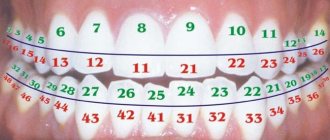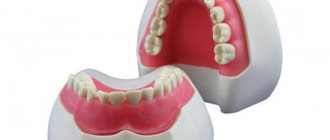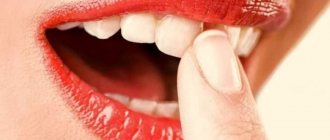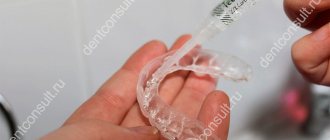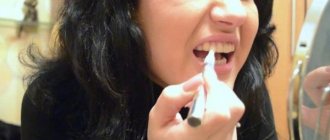“You urgently need to remove the 48th tooth!” - such a statement from the dentist can seriously puzzle the patient, because even from a school biology course everyone knows that there are only thirty-two teeth in the mouth. Where did this mysterious 48th come from, and what is with the strange numbering of teeth among dentists? Cunning doctors have invented a diagram of a person’s teeth with numbers that only they understand, and patients get confused in these numbers, trying to understand what they are talking about and where they suddenly got “extra” dental units from.
In fact, the teeth numbering scheme in dentistry is quite simple, clear and accessible - it was created in order to facilitate the “accounting” of dental units in patients and bring it to some uniform standards. After all, if every dentist starts counting dental units as he pleases, nothing good will definitely come of it. Especially if the patient subsequently gets an appointment with another doctor and he simply does not understand what tooth numbers are indicated in the medical record and what kind of treatment was ultimately carried out earlier.
How dentists count teeth: arrangement and numbering principles
Each dental unit has its own functions, depending on its structure and location on the jaw. Thus, incisors are designed for biting off pieces of food, canines help to hold hard food and “tear off” stubborn pieces, premolars are needed for primary processing, and dense “plump” molars are designed for thoroughly chewing and grinding food. The order of the teeth in the mouth, accordingly, will be as follows: on each jaw there are four incisors, two canines, four premolars (two on each side) and six molars (three on each side).
In dentistry, tooth numbers are assigned according to their location on the jaw and function. Since the incisors and molars are located symmetrically on the right and left, the count starts from the middle of the row, that is, from the central incisors and further to the right and left. If we divide this row into two halves and start counting on one of them, we get: two incisors (teeth numbers 1 and 2), a canine (3rd number), two premolars (4th and 5th), three molar (6th, 7th and 8th, the last one being the wisdom tooth). These are the names and numbers of teeth that are universally accepted in dentistry.
If you have a problem similar to that described in this article, be sure to contact our specialists. Don't diagnose yourself!
Why you should call us now:
- We will answer all your questions in 3 minutes
- Free consultation
- The average work experience of doctors is 12 years
- Convenient location of clinics
Single contact phone number: +7
Make an appointment
But if you simply say “sixth tooth,” then how can you understand whether it is upper or lower, and on which side of the jaw – left or right – it is located? To eliminate confusion in this matter, it is customary to designate a person’s teeth by numbers, indicating the segment of the jaw on which they are located. The segments are considered as follows: the upper right is the first and is indicated by a ten in front of the number of a particular tooth (for example, the 11th is the central right upper incisor, the 16th is the upper right molar, next immediately after the premolars, etc.), the upper left - twenty. Accordingly, the lower left is designated by thirty, and the lower right by the number 40. That is, the segments of the jaws are numbered clockwise, this makes it much easier to remember the order and, if necessary, count.
Thus, the notorious 48th number indicates the location of the wisdom teeth in the lower right segment of the jaw. And insisting on removing the 48th dental unit, the dentist simply indicates what number the wisdom tooth has in the lower right, and does not inform the patient about the supernumerary teeth that came from nowhere in the mouth.
Folk remedies
Grandmother’s recipes at home help alleviate the condition of children:
- Massage.
The swollen gum should be massaged with a finger wrapped in clean, damp gauze. Or dip it in hydrogen peroxide or chamomile decoction. Massage acts as a sedative. - Exposure to cold. Cool the pacifier, pacifier, spoon in the refrigerator. Let your child chew. Cold objects soothe gums and relieve pain. The eruption site will become less swollen.
- Herbal decoctions. To stabilize the psychological state, you can use chamomile tea, infusion of valerian root, and motherwort. Let your child drink 100 ml decoctions 3-4 times a day.
- Rubbing with soda solution. 1 tsp. Dissolve baking soda in a glass of water. Wet a bandage with the solution and wipe the reddened gums. This method helps to disinfect the cavity and relieve swelling.
- Honey. Apply a small amount of honey to your gums. It will relieve inflammation and the pain will subside.
- Roots of strawberry, chicory. Invite your child to chew on the peeled roots. Massage movements will calm the baby and relieve pain.
- Increasing the amount of fluid you drink. Let your child drink water, juices, milk. Diarrhea, vomiting, and refusal to eat provoke dehydration.
What does the diagram of a child’s teeth look like with the numbers of each unit?
The pattern of baby teeth in children differs from the pattern with numbers in adults. Doctors specially designate milk teeth with different numbers so as not to confuse themselves and their patients: after all, a child who was treated for a milk bite in childhood will soon grow up and begin to go to the dentist for treatment of already permanent dental units. And if the same numbering is used in both cases, then there will be incredible confusion in the treatment history - but such a history in the dental record is often extremely important for the further competent and effective elimination of problems of the dental system.
Therefore, the numbering order for baby teeth in children is as follows: the serial number remains the same as in adults (1st, 2nd – incisors, 3rd – canine, etc.), but the segments of the jaws are designated by numbers 50 and 60 for the upper right and left segments and numbers 70 and 80 for the lower left and right, respectively. And when the dentist informs parents that their child has caries on the 82nd tooth, you don’t need to immediately imagine a baby shark with several rows of sharp baby teeth, we are only talking about the second lower right incisor. According to the counting scheme, permanent teeth in children are no different from the scheme of adult molars.
Children's aligners "Flexics"
“Flexics” is an innovative development for the treatment of children aged 6 to 11 years. Many parents ask me during consultations, is it possible to straighten a child’s teeth without plates? Thanks to this it became real! In 2021, aligners (transparent aligners) for children were created, which were called “Flexics”. Unlike plates, treatment with aligners has a number of advantages:
- the ability to move teeth in all planes;
- no violation of diction;
- convenience and maximum aesthetics;
- absence of allergic reactions and metal elements;
- good fixation.
The treatment technology allows you to straighten the child’s teeth that have already erupted and promotes the proper growth of permanent teeth. “Flexics” are manufactured using computer virtual 3D modeling, which provides greater accuracy and visualization of the process of teeth movement. You need to wear Flexics constantly: both day and night, taking it off only when eating and brushing your teeth.
International Viola system: a convenient diagram of the arrangement of a person’s teeth by numbers
The described method is very convenient and most common in dentistry. It has received international recognition and has been generally accepted among dentists since 1971, called the two-digit Viola system. The convenience of such a system lies primarily in the fact that there is no need to create a special map of a person’s teeth, the numbering is easily calculated in the mind and information about the condition of certain dental units of the patient can be easily conveyed in an oral conversation, by telephone or by e-mail.
However, many people, having read this far, may say: but our teeth were counted completely differently, and the map contains completely different designations! That’s right, because in addition to the Viola system, there are several other systems that can be used by dentists.
Partial bracket system “2x4”
Metal bracket system 2x4
Ceramic bracket system 2x4
This system is specially designed for treating children aged 8-9 years. Braces are fixed only on the permanent incisors and first molars, which allows you to quickly correct the position of the front teeth and create space for the lateral group of teeth (which begin to change from temporary to permanent from the age of 9).
Pros of partial braces:
- the ability to correct the position of the front teeth even in the most difficult situations;
- speed of treatment (up to 8-10 months);
- the ability to choose the most invisible braces (ceramic).
An important factor during such treatment is maintaining careful oral hygiene using special toothbrushes and brushes.
Examples before and after treatment
Before treatment
After treatment
Before treatment
After treatment
What other options exist for naming a person’s teeth by numbers?
There are three other systems common among dentists that can be used to designate and record dental units:
- A universal alphanumeric system developed by the American Dental Association.
- Zsigmondy-Palmer system. One of the oldest counting systems (it was created back in 1876), it is often used in their practice by maxillofacial surgeons and orthodontists.
- Haderup system.
All of them are convenient and easy to use in their own way, and in all such systems the arrangement of teeth by numbers in adults and children is indicated differently.
Alphanumeric system
It provides an indication of not only the number of the dental unit, but also its functional purpose. Thus, incisors are designated by the letter I, canines by the letter C, premolars by the letter P and molars by the letter M. As for the numbers, they indicate the serial number of a specific functional unit in the segment (whereas in other systems the functions of the dental unit are not taken into account, only its position is taken into account in a row). For example, if according to the Viola system the wisdom tooth is numbered 8, then according to the alphanumeric system it is also designated as M3, that is, the third molar in the segment. Additionally, digital segment designations are also used, which is why the serial number becomes two-digit. The same 48th tooth mentioned more than once with such a scheme will be designated as M43.
For milk teeth, lowercase (small) Latin letters are used in the recording, and instead of numbers, sometimes letter values from A to K are also indicated, counting dental units clockwise from the upper right incisor.
Zsigmondy-Palmer system
In old, and sometimes in new dental outpatient records, you can see a special plate for recording the condition of dental units, based on the Zsigmondy-Palmer square-numeric system. The order of growth of an adult’s teeth is indicated here by the familiar Arabic numerals from 1 to 8; for children, they use Roman numerals from I to V. The numbers of the jaw segments are not indicated here, the data is simply entered into the corresponding parts of the table diagram. The system is quite convenient and visual, but in an oral conversation it can cause difficulties when indicating a specific dental unit.
How to draw a person's mouth with a pencil
Drawing a mouth is not easy. However, it is quite possible to simplify this task if we conditionally break it down into simple geometric shapes. This will make it much easier to immediately see the proportions of the mouth, construct it, and then move on to finer detailing.
Lips come in many different shapes and can have any emotional mood. However, the rule of simplifying the original form is relevant for absolutely any case. Therefore, you can safely use it.
Today we will learn how to depict a slightly open mouth with teeth, as well as a mouth in a relaxed position. For both works we will need paper, simple pencils of varying softness and a good soft eraser.
